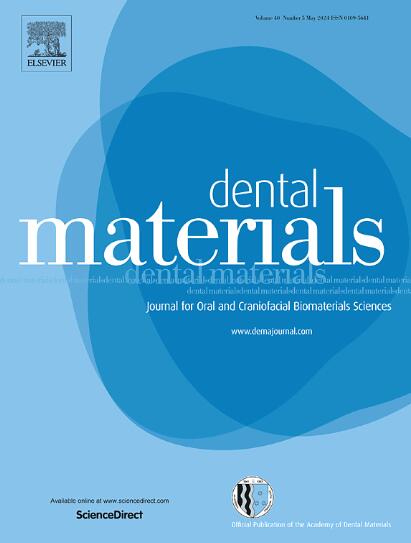后牙直接与间接复合树脂修复体的寿命:系统回顾和荟萃分析。
IF 6.3
1区 医学
Q1 DENTISTRY, ORAL SURGERY & MEDICINE
引用次数: 0
摘要
研究目的本系统综述和荟萃分析旨在比较后牙直接和间接复合树脂修复体的寿命:研究后恒牙直接和间接复合树脂修复体的随机对照试验(RCT):资料来源:筛选了三个电子数据库(PubMed、CENTRAL(Cochrane)和 Embase)。无语言或时间限制。研究选择、数据提取和质量评估均一式两份。使用 Risk of Bias 2.0 工具和 Grade Profiler 3.6 对偏倚风险和证据水平进行分级:结果:电子数据库共检索到 3056 篇文章。最后,选择了 5 篇研究性临床试验。共有 279 名患者(年龄在 28-81 岁之间)接受了 627 次修复,其中 323 次为直接复合修复,304 次为间接复合修复。间接修复体的年失败率(AFR)最高,从 0% 到 15.5%。直接修复体的年失败率较低,从 0% 到 5.4%。最常见的故障是修复体崩裂和断裂,其次是龋坏。Meta 分析显示,直接修复体的失败率明显低于间接修复体(风险比 (RR) [95 %CI] = 0.61 [0.47; 0.79];证据级别很低)。此外,所有研究的偏倚风险都很高:结论:对于单牙修复包括后牙尖牙覆盖在内的大型 II 类龋洞,可推荐使用直接和间接复合树脂修复体。Meta 分析显示,直接复合树脂修复失败的相对风险明显低于间接修复,但结果具有较高的依据风险。本文章由计算机程序翻译,如有差异,请以英文原文为准。
Longevity of posterior direct versus indirect composite restorations: A systematic review and meta-analysis
Objectives
The goal of this systemic review and meta-analysis was to compare the longevity of direct and indirect composite restorations in posterior teeth.
Data
Randomized controlled trials (RCT) investigating direct and indirect composite restorations in permanent posterior teeth.
Sources
Three electronic databases (PubMed, CENTRAL (Cochrane) and Embase) were screened. No language or time restrictions were applied. Study selection, data extraction and quality assessment were done in duplicate. Risk of bias and level of evidence was graded using Risk of Bias 2.0 tool and Grade Profiler 3.6.
Results
A total of 3056 articles were found by electronic databases. Finally, five RCTs were selected. Overall, 627 restorations of which 323 were direct and 304 indirect composite restorations have been placed in 279 patients (age: 28–81 years). The highest annual failure rates (AFR) were found for indirect restorations ranging from 0 % to 15.5 %. Lower AFR were found for direct restorations ranging from 0 % to 5.4 %. The most frequent failures were found to be chipping and fracture of the restoration followed by caries. Meta-analysis revealed that the failure rate for direct restorations was significantly lower than for indirect restorations (Risk Ratio (RR) [95 %CI] = 0.61 [0.47; 0.79]; very low level of evidence). Furthermore, all studies showed a high risk of bias.
Conclusion
Direct and indirect composite restorations can be recommended for large class II cavities including cusp coverage in posterior teeth for single tooth restoration. Meta-analysis revealed significantly lower relative risk to fail for direct composite restorations than for indirect restorations but results are with high risk of basis.
求助全文
通过发布文献求助,成功后即可免费获取论文全文。
去求助
来源期刊

Dental Materials
工程技术-材料科学:生物材料
CiteScore
9.80
自引率
10.00%
发文量
290
审稿时长
67 days
期刊介绍:
Dental Materials publishes original research, review articles, and short communications.
Academy of Dental Materials members click here to register for free access to Dental Materials online.
The principal aim of Dental Materials is to promote rapid communication of scientific information between academia, industry, and the dental practitioner. Original Manuscripts on clinical and laboratory research of basic and applied character which focus on the properties or performance of dental materials or the reaction of host tissues to materials are given priority publication. Other acceptable topics include application technology in clinical dentistry and dental laboratory technology.
Comprehensive reviews and editorial commentaries on pertinent subjects will be considered.
 求助内容:
求助内容: 应助结果提醒方式:
应助结果提醒方式:


